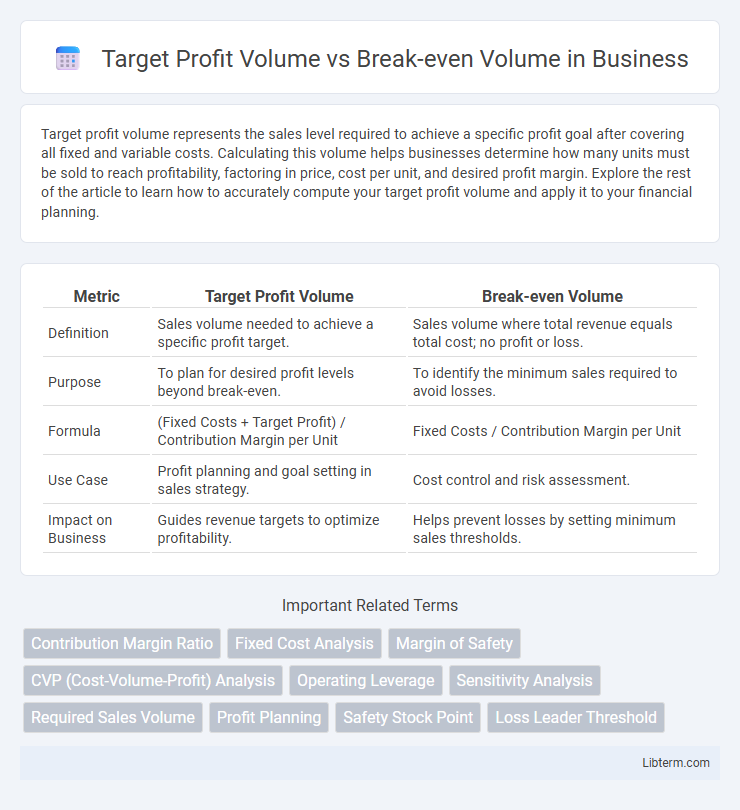Target profit volume represents the sales level required to achieve a specific profit goal after covering all fixed and variable costs. Calculating this volume helps businesses determine how many units must be sold to reach profitability, factoring in price, cost per unit, and desired profit margin. Explore the rest of the article to learn how to accurately compute your target profit volume and apply it to your financial planning.
Table of Comparison
| Metric | Target Profit Volume | Break-even Volume |
|---|---|---|
| Definition | Sales volume needed to achieve a specific profit target. | Sales volume where total revenue equals total cost; no profit or loss. |
| Purpose | To plan for desired profit levels beyond break-even. | To identify the minimum sales required to avoid losses. |
| Formula | (Fixed Costs + Target Profit) / Contribution Margin per Unit | Fixed Costs / Contribution Margin per Unit |
| Use Case | Profit planning and goal setting in sales strategy. | Cost control and risk assessment. |
| Impact on Business | Guides revenue targets to optimize profitability. | Helps prevent losses by setting minimum sales thresholds. |
Understanding Target Profit Volume
Target Profit Volume represents the sales quantity needed to achieve a specific profit level, calculated by dividing fixed costs plus target profit by contribution margin per unit. This volume exceeds the Break-even Volume, which covers only fixed and variable costs without profit. Understanding Target Profit Volume helps businesses set realistic sales goals to ensure profitability beyond just breaking even.
Defining Break-even Volume
Break-even volume is the sales level at which total revenues equal total costs, resulting in zero profit or loss. It is calculated by dividing fixed costs by the contribution margin per unit, providing a critical threshold to determine business viability. Target profit volume extends this concept by incorporating desired profit into the equation, indicating the sales volume needed to achieve specific profit goals.
Key Differences Between Target Profit and Break-even Volume
Target Profit Volume represents the sales volume needed to achieve a specific profit target, while Break-even Volume is the sales volume where total revenues equal total costs, resulting in zero profit. Target Profit Volume calculation incorporates desired profit margins in addition to fixed and variable costs, contrasting with Break-even Volume which only covers fixed costs. Understanding these distinctions aids businesses in strategic planning by aligning sales goals with profitability expectations.
Importance in Financial Planning
Target profit volume and break-even volume are critical metrics in financial planning, as they determine the sales needed to achieve specific financial goals. Break-even volume indicates the minimum sales level required to cover fixed and variable costs, ensuring no loss, while target profit volume calculates the sales needed to attain a desired profit margin. Understanding these volumes allows businesses to set realistic sales targets, manage costs effectively, and optimize profitability strategies.
Calculating Break-even Volume: Step-by-Step
Calculating break-even volume requires dividing total fixed costs by the contribution margin per unit, which is the selling price per unit minus variable cost per unit. For example, if fixed costs are $50,000, the selling price per unit is $25, and variable costs per unit are $15, the contribution margin is $10, resulting in a break-even volume of 5,000 units. This calculation identifies the minimum sales units needed to cover all costs before generating profit, making it essential for financial planning and decision-making.
Calculating Target Profit Volume: A Practical Approach
Calculating Target Profit Volume involves determining the sales volume needed to achieve a specific profit by using the formula: Target Profit Volume = (Fixed Costs + Target Profit) / Contribution Margin per Unit. This approach requires accurate identification of fixed costs, variable costs per unit, and the selling price to ensure precise contribution margin calculation. By focusing on these key financial metrics, businesses can strategically plan sales targets to meet desired profit objectives beyond the break-even point.
Factors Influencing Both Volumes
Target profit volume and break-even volume are influenced primarily by fixed costs, variable costs per unit, and the selling price per unit, with changes in any of these factors directly impacting the required sales volume. Higher fixed costs or lower selling prices increase both target profit and break-even volumes, while reductions in variable costs per unit decrease them, enhancing profitability. Market demand, competitive pricing strategies, and operational efficiencies also play critical roles in shaping the relationship between target profit volume and break-even volume.
Real-World Business Applications
Target profit volume calculates the sales needed to achieve a specific profit level beyond just covering fixed and variable costs, offering businesses a strategic tool for revenue planning and profitability forecasting. Break-even volume identifies the minimum sales quantity required to avoid losses, serving as a critical benchmark for cash flow management and risk assessment. In practice, companies use target profit volume to set ambitious sales goals aligned with financial objectives, while break-even volume informs pricing strategies and cost control measures to ensure operational sustainability.
Common Mistakes to Avoid
Confusing target profit volume with break-even volume is a frequent mistake, as break-even volume covers only fixed and variable costs without generating profit, while target profit volume includes desired profit margins. Neglecting to accurately calculate variable costs per unit can lead to incorrect volume estimates, resulting in underperformance or unexpected losses. Overlooking changes in fixed costs or price fluctuations further distorts break-even and target profit analyses, causing flawed business decisions.
Strategic Decision-Making Using Volume Analysis
Target profit volume pinpoints the sales level needed to achieve a specific profit, guiding pricing and production strategies. Break-even volume identifies the minimum sales required to cover all costs, serving as a critical threshold for financial viability. Integrating volume analysis into strategic decision-making enables businesses to optimize resource allocation and forecast profitability under varying market conditions.
Target Profit Volume Infographic

 libterm.com
libterm.com